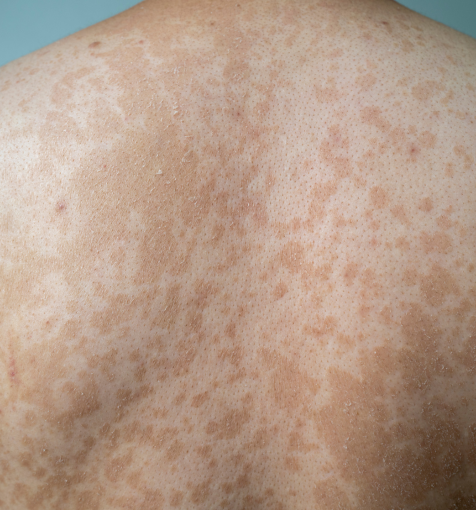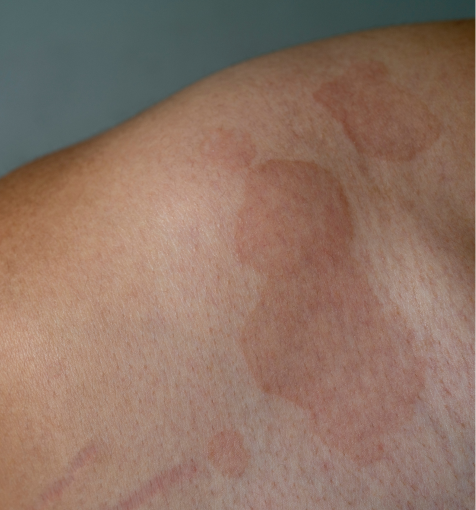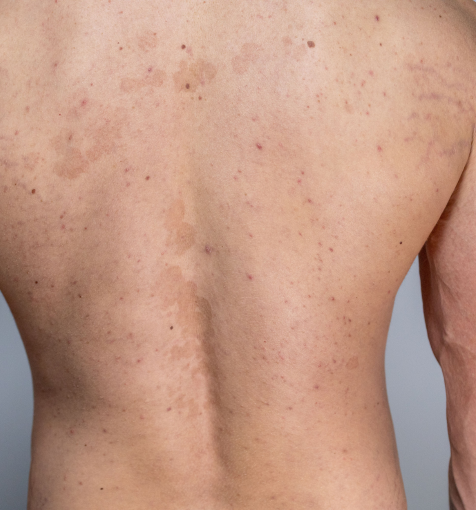Correct Fungus-Related Skin Discoloration in New Jersey
Tinea versicolor, also known as pityriasis versicolor, is a common fungal skin condition that causes patches of discolored skin. These patches can appear lighter or darker than the surrounding skin, and may be brown, tan, pink, or reddish. While generally harmless and non-contagious, tinea versicolor can be bothersome due to its appearance or mild itchiness. At Skin & Laser Center of NJ, we provide effective, noninvasive treatments to restore a more even, healthy skin.


Tinea versicolor occurs when the naturally occurring yeast on the skin grows out of control. Factors that increase the likelihood of developing this condition include:
Hot and humid climates
Excessive sweating or oily skin
Weakened immune system
Adolescence or young adulthood
The yeast responsible for tinea versicolor can also contribute to other skin disorders, including pityrosporum folliculitis (which resembles acne) and seborrheic dermatitis (dandruff).
Tinea versicolor is typically noticeable as flat, discolored patches on the skin. Common characteristics include:
Patches that are brown, tan, pink, reddish, or lighter than surrounding skin
Dry or flaky texture within affected areas
Mild itchiness in some cases
Most commonly appearing on the chest, back, abdomen, and neck
While usually painless, patients often seek treatment for cosmetic reasons or persistent irritation.


Our providers offer a variety of treatment methods to effectively manage tinea versicolor, including:
Topical antifungal medications: Creams or lotions applied directly to the affected area
Oral antifungal medications: Prescribed for more widespread or persistent infections
Preventive guidance: Tips on skin care, hygiene, and avoiding triggers to reduce recurrence
With professional care, most patients see significant improvement, and treatments can help prevent future flare-ups while restoring clearer, healthier skin.
Learn More About Tinea Versicolor
Many patients with tinea versicolor don’t experience itching or other physical discomfort associated with the condition and might not feel compelled to seek treatment. Other patients might be uncomfortable about the appearance of the rash and seek assistance and treatment from a trained medical professional.
The first step in treating tinea versicolor is obtaining an official diagnosis. At Skin & Laser Center of NJ a provider can often conduct a visual examination of the skin to determine whether a patient has the fungus. With treatment, the yeast that causes tinea versicolor is easy to kill.
The best treatment depends on where the tinea versicolor is located on the body, how much of the skin is affected, how thick the spots have grown, and the climate. Available treatment options for tinea versicolor may include topical medical body washes, topical creams and lotions, or antifungal pills. In many cases, the patient will need to apply the medications for several weeks to months in order to benefit from the full effect.
After successful treatment, the skin may stay lighter (or darker) for weeks or months, but will eventually return to its normal color. Tinea versicolor can return even after a successful treatment, so prevention is important. An occasional medicated body wash may be recommended. It’s also important to use sunscreen to help protect the skin during this time.
Convenient walk in hours available below. No appointment needed! Accepting private insurance and medicare. No medicaid plans.
Learn more about medical treatments at New Jersey’s Skin & Laser Center of NJ. Call 201-500-7525 or contact us online to schedule a consultation.